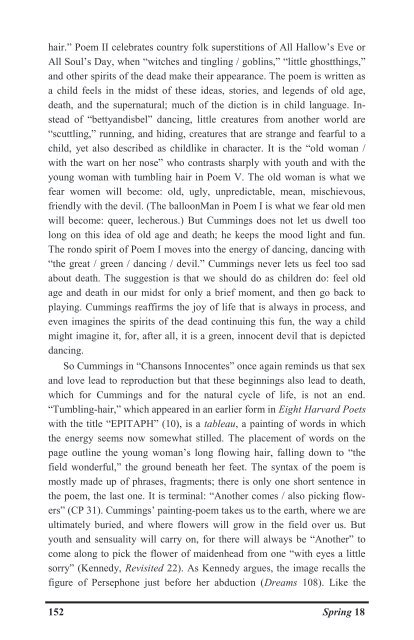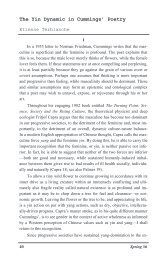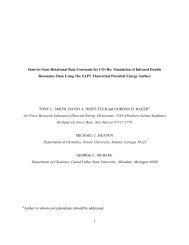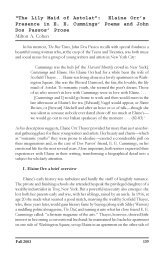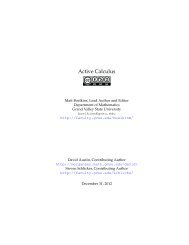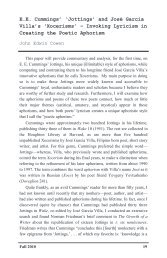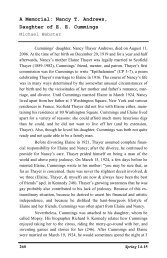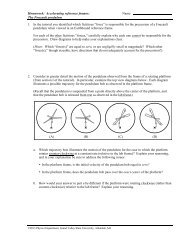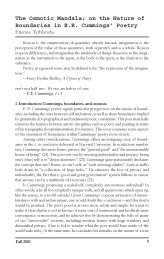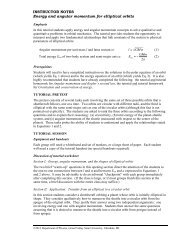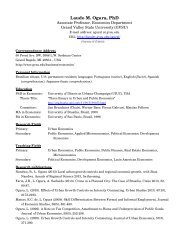The Aesthetics of EE Cummings' âin Just-â - Gvsu
The Aesthetics of EE Cummings' âin Just-â - Gvsu
The Aesthetics of EE Cummings' âin Just-â - Gvsu
- No tags were found...
Create successful ePaper yourself
Turn your PDF publications into a flip-book with our unique Google optimized e-Paper software.
hair.” Poem II celebrates country folk superstitions <strong>of</strong> All Hallow’s Eve orAll Soul’s Day, when “witches and tingling / goblins,” “little ghostthings,”and other spirits <strong>of</strong> the dead make their appearance. <strong>The</strong> poem is written asa child feels in the midst <strong>of</strong> these ideas, stories, and legends <strong>of</strong> old age,death, and the supernatural; much <strong>of</strong> the diction is in child language. Instead<strong>of</strong> “bettyandisbel” dancing, little creatures from another world are“scuttling,” running, and hiding, creatures that are strange and fearful to achild, yet also described as childlike in character. It is the “old woman /with the wart on her nose” who contrasts sharply with youth and with theyoung woman with tumbling hair in Poem V. <strong>The</strong> old woman is what wefear women will become: old, ugly, unpredictable, mean, mischievous,friendly with the devil. (<strong>The</strong> balloonMan in Poem I is what we fear old menwill become: queer, lecherous.) But Cummings does not let us dwell toolong on this idea <strong>of</strong> old age and death; he keeps the mood light and fun.<strong>The</strong> rondo spirit <strong>of</strong> Poem I moves into the energy <strong>of</strong> dancing, dancing with“the great / green / dancing / devil.” Cummings never lets us feel too sadabout death. <strong>The</strong> suggestion is that we should do as children do: feel oldage and death in our midst for only a brief moment, and then go back toplaying. Cummings reaffirms the joy <strong>of</strong> life that is always in process, andeven imagines the spirits <strong>of</strong> the dead continuing this fun, the way a childmight imagine it, for, after all, it is a green, innocent devil that is depicteddancing.So Cummings in “Chansons Innocentes” once again reminds us that sexand love lead to reproduction but that these beginnings also lead to death,which for Cummings and for the natural cycle <strong>of</strong> life, is not an end.“Tumbling-hair,” which appeared in an earlier form in Eight Harvard Poetswith the title “EPITAPH” (10), is a tableau, a painting <strong>of</strong> words in whichthe energy seems now somewhat stilled. <strong>The</strong> placement <strong>of</strong> words on thepage outline the young woman’s long flowing hair, falling down to “thefield wonderful,” the ground beneath her feet. <strong>The</strong> syntax <strong>of</strong> the poem ismostly made up <strong>of</strong> phrases, fragments; there is only one short sentence inthe poem, the last one. It is terminal: “Another comes / also picking flowers”(CP 31). Cummings’ painting-poem takes us to the earth, where we areultimately buried, and where flowers will grow in the field over us. Butyouth and sensuality will carry on, for there will always be “Another” tocome along to pick the flower <strong>of</strong> maidenhead from one “with eyes a littlesorry” (Kennedy, Revisited 22). As Kennedy argues, the image recalls thefigure <strong>of</strong> Persephone just before her abduction (Dreams 108). Like the152 Spring 18


